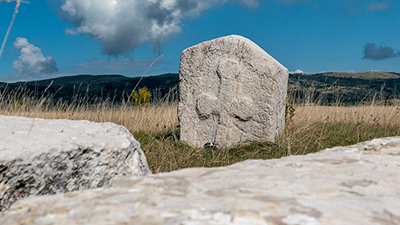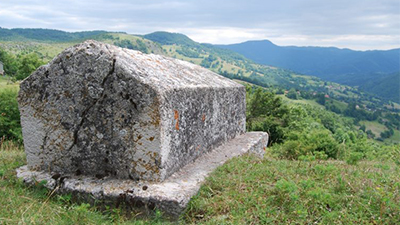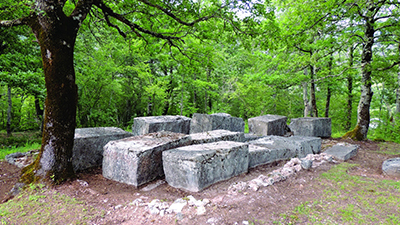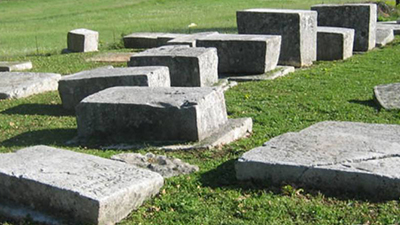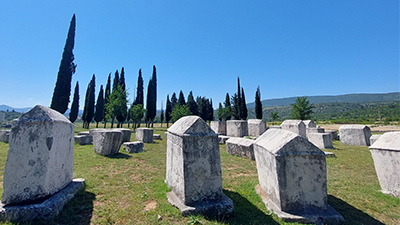Stećak tombstones – stone tombstones of medieval Bosnia
Stećak tombstones are medieval Bosnian stone tombstones. During the Middle Ages, they were erected on the territory where the Bosnian state spread. Today, stećak tombstones are found in Bosnia and Herzegovina, Croatia, Serbia, and Montenegro. Necropolis refers to a group of stećak tombstones located together. Stećak tombstones were erected between the 13th and the end of the 15th century. There were several names for these monuments during the Middle Ages, including: bilig, kâm, zlamen, kuća, vječni dom. In later centuries, they were called: stećci, mramorje, grčko groblje, kaursko groblje, vječni dom, divsko groblje, mašet. Depending on their form, they can be divided into lying and standing monuments. The forms are as follows: slab, chest, chest with plinth, gable, gable with plinth, pillar and cross. Stećak tombstones in the form of gravestones represent the transitional phase from stećak tombstones to gravestones and are related to the period of the end of the 15th and the beginning of the 16th century. All the listed forms include more sub-types. A small number of stećak tombstones have various motifs and inscriptions carved in. There are several divisions of motifs on stećak tombstones, one of them divides them into ornaments, figure representations and other decorative signs. According to the latest records, the number of inscriptions on stećak tombstones is over 400. The inscriptions are written in the Slavic language in the medieval Bosnian variant of the Cyrillic script. Certain inscriptions also contain the date, which is written in letters of the usual numerical value, and in such cases it is possible to precisely determine the time when the tombstone was placed.
Stećak tombstones seem to be a part of an unbroken continuity of sepulchral culture that dates back to prehistoric times. Thus, the connection of stećak with the localities of older epochs becomes clear and strong – prehistoric settlements and cult places, ancient agglomerations and cemeteries, late antique and early medieval churches and fortified towns. Stećak tombstones, as tombstones of the medieval era, served three major purposes: commemorating a deceased family member, expressing full function through service or genealogical flow, and ensuring an ongoing flow of prayers in favor of the deceased. It is not known whether the stećak was placed immediately after the burial of the deceased or after a certain period of time had passed. Stećak tombstones, along their length, are mostly oriented in the west-east direction. The deceased person, regardless of gender and age, was always laid in a coffin in a lying position, on his back, so that his head was on the west side and his legs on the east side. The main orientation was based on the apparent path of the sun, with sunrise being the highest point of view. Under the stećak, the deceased were buried with money, jewelry, weapons, clothes, dishes, and other objects from medieval human everyday life. Multidisciplinary research has shown that stećak tombstones are multi-confessional monuments, erected by members of all religions in the medieval Bosnian state. This includes Catholics, Orthodox and followers of the teachings of the Bosnian Church. Vlachs on the territory of Bosnia were also buried under the stećak. These monuments represented a Bosnian cultural phenomenon that stretched beyond the religious perception of marking burial sites.
The emergence of the stećak as a monumental burial architecture can be directly correlated to the increased economic potential of Bosnian feudal society, i.e., the desire of individuals to assert their reputation and power by external signs on tombstones. Creating and erecting stećak was a complex process and required large financial resources. Stone found near the necropolis was used to make the stećak, primarily limestone, and more compact and high-quality finds were selected. Work on stone masonry began in the quarry, where strong and dexterous workers were employed. To transport the stećak from the quarry to the necropolis, specially made wooden carriages were used, with horse and ox carts, and when the monument was very heavy, it was also pushed over oak logs. Stonemasons and inscription scribes were sometimes mentioned by name in the inscriptions on stećak tombstones. Historians who have dealt with this issue have established the existence of several stone masonry schools on the territory of the Bosnian state, known ones from the vicinity of Stolac, Trebinje, Bileća, Gacko, Nevesinje, Konjic, Kupres, Duvno, Travnik, Ilijaš, Zvornik, Ludmer, Rogatica.
After the collapse of medieval Bosnia and the Ottoman conquest of this area, the role, function and importance of the stećak was completely forgotten by later generations of the local population. During the previous centuries, many folk tales and stories have been created about stećak tombstones. A lack of basic information concerning this type of monument has led to the creation of these folk tales. A total of 28 stećak necropolises are included on the UNESCO World Heritage List. It is believed that around 60,000 stećak tombstones have been preserved today in over 3,000 necropolises or localities. According to some estimates, their number was twice as high.
Sources and literature:
- Bešlagić Šefik, Stećci – kultura i umjetnost, Veselin Masleša, Sarajevo 1982.
- Bešlagić Šefik, Stećci. Kataloško-topografski pregled, Veselin Masleša, Sarajevo 1971, 11-59.
- Bešlagić Šefik, “Oblici stećaka”, Radovi ANUBiH, vol. 18, no. 15, Sarajevo 1972, 173-213.
- Bešlagić Šefik, Leksikon stećaka, Svjetlost, Sarajevo 2004, 17-188.
- Lovrenović Dubravko, Stećci. Bosansko i humsko mramorje srednjeg vijeka, Rabic, Sarajevo 2009, 17-128.
- Marijanović Pero, “Postanak, klesanje i transport stećaka”, Hercegovina, no. 21, Mostar 2007, 93-112.
- Miletić Nada, Stećci, Jugoslavija-Spektar-Prva književna komuna, Beograd-Zagreb-Mostar 1982.
Wenzel Marian, Ukrasni motivi na stećcima, Veselin Masleša, Sarajevo 1965.
Dugo Polje in Blidinje
Blidinje is a karst plateau between Čvrsnica and Vran mountains that belongs to the municipalities of Jablanica and Posušje. At the foot of the Vran mountain in the southwest-northeast direction is a field called Dugo polje, after which the entire area got its name. A...
Pavlovac
The Pavlovac necropolis was located on the Pavlovac hill not far from Kasindol in the immediate vicinity of Sarajevo. Medieval roads led along the necropolis itself, one passing through Kasindol and along the southern slopes of Pavlovac via Križ and Tvrdimić, leading...
Biskup near Konjic
The “Grčka glavica” necropolis in the village of Biskup near Glavatičevo is 30 kilometers southeast of Konjic. The area was part of the medieval county of Kom. In this area, there remains of a church and a stećak necropolis. The necropolis has a total of 172 stećak...
Boljuni
The necropolis in Boljuni is one of the most impressive stećak necropolises in Bosnia and Herzegovina. The construction technique, preservation, ornamentation, and large number of inscriptions rank this necropolis among the most important for researching the history,...
Radimlja
There is no doubt that Radimlja’s necropolis is one of the most impressive and well-known necropolises of stećak tombstones in general. It is fair to state that this necropolis has an iconic cultural character. This site is located in Stolac, an area that represents...


